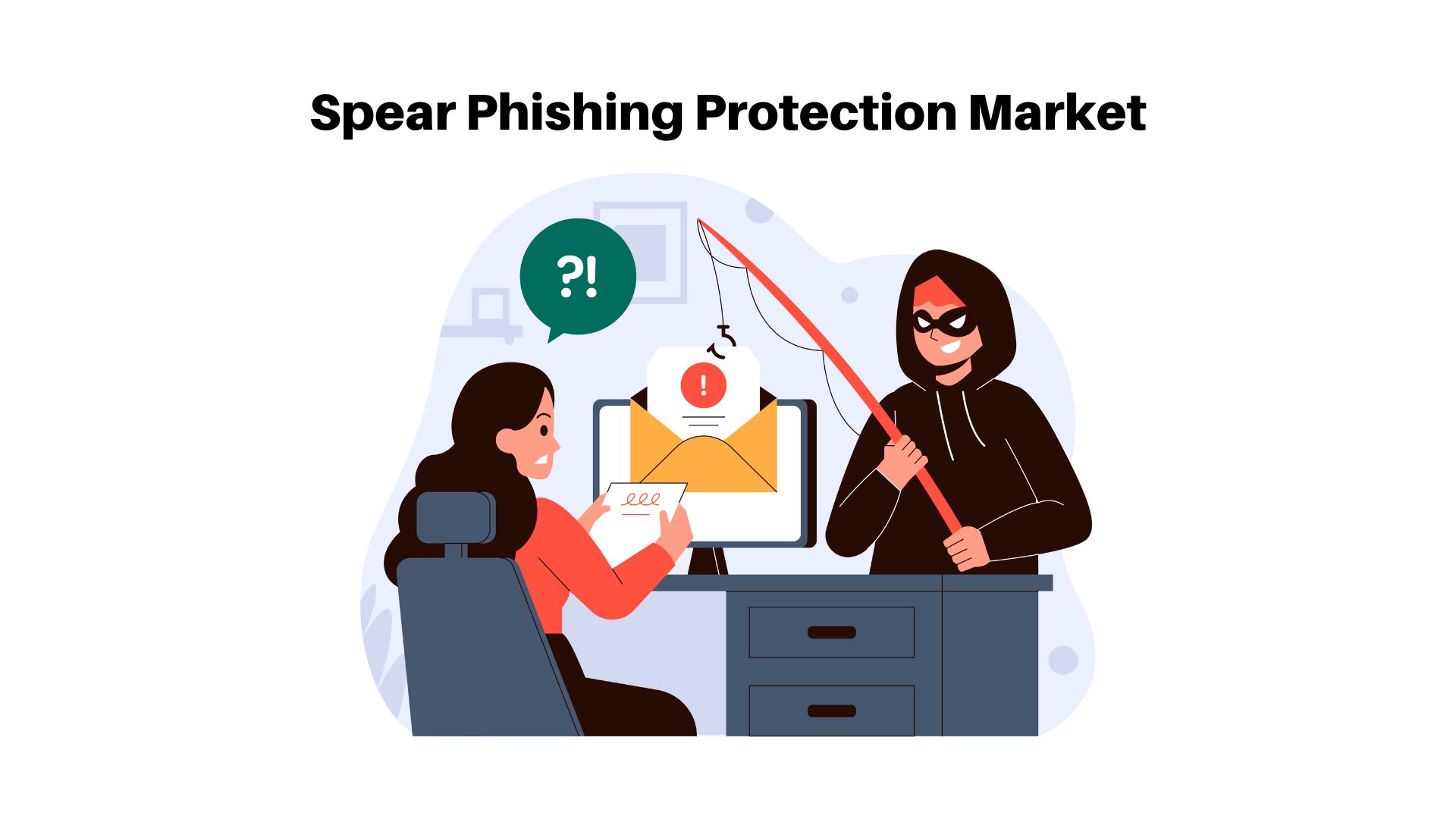Spear Phishing Protection Market Will Anticipate Around USD 3.87 Bn by 2033

Page Contents
Market Overview
Published Via 11Press: Spear phishing is a type of cyber attack that targets an individual or group by sending fraudulent emails or other forms of communication that appear to come from trusted sources. These scams aim to trick the recipient into providing sensitive information or performing actions which could compromise personal and organizational security. To protect against Spear phishing Market attacks, it's essential to implement strong security measures which can detect and block malicious messages before they reach their intended recipient.
The Global Spear Phishing Protection Market represented USD 1.41 Bn in 2022 and will anticipate around USD 3.87 Bn by 2033 projected around CAGR of 9.59% amid forecast frame of 2023 to 2033.
Educating employees on how to recognize and respond to phishing attacks is essential in preventing successful attacks. Training should cover topics such as recognizing suspicious emails, not clicking on links or downloading attachments from unknown sources, and reporting any suspicious activity to the appropriate security team. Enabling MFA adds an additional layer of security to prevent unauthorized access to sensitive data or systems, helping shield against spear phishing attacks even if an attacker gains access to a user's login credentials. Web filtering tools can block access to known malicious websites or those used in spear phishing attacks, such as those that imitate legitimate login pages.
Key Takeaways
- Spear phishing is a cyber attack that targets an individual or group by sending fraudulent emails or other forms of communication that appear to come from trusted sources. To protect against spear phishing attempts, strong security measures are needed that can identify and block malicious messages before they reach their intended recipient. Key strategies for spear phishing protection include employee training, multi-factor authentication, email filtering/web filtering software, anti-malware software and regular security audits. Educating employees on how to detect and respond to phishing attempts is key in preventing successful attacks from taking place.
- Enabling multi-factor authentication adds an additional layer of protection to prevent unauthorized access to sensitive data or systems. Email and web filtering tools can scan incoming content for suspicious patterns that could indicate a phishing attempt and block access to known malicious websites. Anti-malware software scans attachments or links within emails in order to detect and block any malicious material. Regular security audits identify potential vulnerabilities and guarantee all security measures are up-to-date and effective. It's essential for individuals and companies alike to remain vigilant with regards to security threats and best practices so as to offer the highest level of protection possible.

Get Spear Phishing Protection Market Sample Report: https://marketresearch.biz/report/spear-phishing-protection-market/request-sample/
Regional Snapshot
- North America has become a prime target for spear phishing attacks, especially against high-value targets like government agencies, financial institutions and large corporations. To combat this risk many organizations in North America have implemented advanced security measures such as multi-factor authentication, email and web filtering systems, along with regular security audits to stay ahead of potential attacks.
- Europe has become a prime target for spear phishing attacks, especially targeting financial institutions and government agencies. Many organizations in Europe have implemented stringent data protection regulations such as the General Data Protection Regulation (GDPR), which requires companies to take strong precautions when handling sensitive data.
- Asia has become an increasingly attractive target for spear phishing attacks, often targeting financial institutions and government agencies in the region. However, the specific methods employed may differ from those seen elsewhere; attackers here often employ social engineering techniques that take advantage of cultural and social norms to access sensitive data.
- Latin America has seen an uptick in spear phishing attacks over the last several years, many of which target small and medium-sized businesses. While many organizations in the region have implemented basic security measures like anti-malware software and employee training, there remains a need for greater awareness and education regarding the dangers associated with spear phishing attempts.
Inquire with our industry specialist: https://marketresearch.biz/report/spear-phishing-protection-market/#inquiry
Drivers
- Spear phishing attacks have become increasingly sophisticated, employing techniques such as social engineering and artificial intelligence to craft convincing fake emails or other forms of communication. As more organizations turn to the cloud for their computing needs, they are storing more sensitive data there, leaving them more susceptible to spear phishing attacks. The COVID-19 pandemic has hastenened the trend toward remote work, creating an increased opportunity for spear phishing attacks to expand. Remote workers may be particularly vulnerable if they use personal devices or work from unprotected networks.
- Many industries are subject to stringent data protection regulations, such as GDPR in Europe and HIPAA in the US. Neglecting to safeguard against spear phishing attacks can result in harsh penalties and lasting reputational harm. Spear phishing attacks can result in significant financial losses for both individuals and organizations alike. In some cases, attackers may use spear phishing techniques to gain access to sensitive financial data or carry out fraudulent transactions. With increased awareness of cyber risks, individuals and organizations are realizing the need for stronger cybersecurity measures – including protection from spear phishing attacks.
Restraints
- Even the most sophisticated spear phishing protection software cannot guarantee complete protection from human error. Employees who are unaware of the risks and how to detect and avoid these attacks may unwittingly fall prey to a phishing attempt. Not all spear phishing protection software is created equal. Some systems may have vulnerabilities or gaps in protection that could be exploited by attackers. Therefore, selecting a reliable, up-to-date program with an established record of success at preventing spear phishing attacks is paramount. Attackers are constantly developing new methods to circumvent spear phishing protection measures. To remain ahead of these threats, it is essential that the software and protocols used for protection are regularly updated and upgraded.
- Effective spear phishing protection requires a significant investment of both personnel and technology. Organizations that lack sufficient manpower or resources may not be able to adequately guard against spear phishing attacks. Some anti-phishing measures may generate false positives, misidentifying legitimate emails as phishing attempts. This causes extra work for employees who must review and verify these messages, leading to frustration and decreased productivity levels.
Opportunities
- Spear phishing is a type of phishing attack that targets specific individuals or organizations with tailored messages designed to coerce the victim into sharing sensitive information or taking certain actions. Spear phishing attacks are particularly successful since they appear to come from an established source and contain relevant details that pertain to the target.
- The primary and most essential step in protecting against spear phishing attacks is education of employees on how to recognize and respond to them. Staff should be taught to be wary of suspicious emails, with encouragement given for them to be reported directly to their IT department. Email filtering can help detect and block malicious emails before they reach their intended recipients. Advanced filtering methods use machine learning algorithms to analyze email content to detect potential spear phishing attempts. Two-factor authentication can help protect sensitive information by requiring users to provide an additional form of verification, such as a code sent directly to their mobile device, before being allowed access certain systems or applications.
Challenges
- Spear phishing is a type of phishing attack that targets specific individuals or organizations with personalized messages in an effort to coax them into sharing sensitive information or taking certain actions. Although there are several strategies for guarding against spear phishing attacks, organizations may still face some difficulties. No matter how well-intentioned training and awareness campaigns are, employees can still become victims of spear phishing attacks if they are not vigilant or neglect to pay attention. Human error remains one of the greatest obstacles to successful spear phishing protection, and organizations must constantly remind employees about the significance of being cautious and adhering to security protocols. Cybercriminals are constantly developing more advanced spear phishing tactics that can circumvent traditional security measures. For instance, some attacks may use social engineering techniques that are harder to detect, like pretexting or impersonation.
- Implementing successful spear phishing protection strategies necessitates a significant investment of resources, such as security technologies, training programs and risk assessments. Unfortunately, some organizations lack either the funds or expertise to develop and sustain an effective security posture. Legacy systems and outdated software may be more vulnerable to spear phishing attacks due to their lack of security features and updates. Upgrading these systems can be expensive and time-consuming, making it a non-viable option for some organizations. Spear phishing attacks typically originate from external sources, but insider threats can also pose a significant danger. Adversaries within an organization may use spear phishing tactics to gain access to sensitive data or systems, or plant malicious software within the network.
Market Segmentation
Global Spear Phishing Protection Market, By Component
- Solutions
- Cloud
- Hybrid
- On-Premises
- Services
- Professional service
- Managed Service
Global Spear Phishing Protection Market, By Protection Type
- Data Leak Protection
- Email Encryption
- Multi-Layered Malware Protection
- Social Engineering Protection
- Zero-Day Prevention
- Others (Denial of Service (DoS) Attack protection and ransomware protection)
Global Spear Phishing Protection Market, By End-Use Industry
- Financial Services
- Insurance
- Defense
- Healthcare
- Government & Public Sector
- Retail and Consumer Goods
- Telecommunication
- Others (media & entertainment, transportation, and education)
Key Players
- Microsoft Corporation,Symantec Corporation
- BAE Systems
- GreatHorn, Inc.
- Cisco Systems Inc.
- FireEye Inc.
- Proofpoint, Inc.
- Intel Corporation
- Mimecast Ltd.
- Phishlabs
Report Scope
| Report Attribute | Details |
| Market size value in 2022 | USD 1.41 Bn |
| Revenue forecast by 2033 | USD 3.87 Bn |
| Growth Rate | CAGR Of 9.59% |
| Regions Covered | North America, Europe, Asia Pacific, Latin America, and Middle East & Africa, and Rest of the World |
| Historical Years | 2017-2022 |
| Base Year | 2022 |
| Estimated Year | 2023 |
| Short-Term Projection Year | 2028 |
| Long-Term Projected Year | 2033 |
Growing Demand => Request for Customization
Recent Developments
- AI and Machine Learning (ML) are being utilized to analyze email communications to detect patterns that could indicate spear phishing attempts. These technologies also allow companies to develop personalized training programs tailored specifically for each employee's level of risk. Behavioral analysis techniques are being employed to detect anomalies in employee behavior that could indicate a spear phishing attempt. By monitoring employee activity across different systems and applications, it's possible to spot unusual patterns that could indicate a security threat. MFA (Multi Factor Authentication) is becoming more and more common as a means to safeguard sensitive information from unauthorized access. By requiring users to supply multiple forms of authentication such as a password and biometric scan, MFA helps prevent spear phishing attacks that use stolen credentials.
- Security awareness training is being designed to give employees more targeted and engaging training programs tailored to their roles and responsibilities. This helps increase the efficiency of instruction while decreasing the risk of employees falling victim to spear phishing attacks. Organizations are increasingly sharing threat intelligence among themselves in order to detect and prevent spear phishing attempts. By sharing information about known threats and attack techniques, businesses can better safeguard themselves and their customers from such scams.
Key Questions
What is spear phishing, and how is it different from phishing?
Spear phishing is a type of phishing attack that targets specific individuals or organizations with personalized messages designed to trick the victim into sharing sensitive information or performing certain actions. On the other hand, phishing refers more generally to any attempt to deceive individuals into disclosing sensitive data by impersonating an established entity.
What are some common spear phishing tactics?
Some common spear phishing techniques use social engineering techniques like pretexting or impersonation to gain the victim's trust. An attacker may also draw information from social media or other public sources in order to personalize the message and increase its persuasiveness.
What are some effective spear phishing protection strategies?
Effective spear phishing protection tactics involve employee training, email filtering, two-factor authentication, endpoint protection and risk assessments. Furthermore, having an organized incident response plan in place helps respond quickly and effectively to any potential attacks.
What challenges may organizations encounter when implementing spear phishing protection strategies?
Organizations may experience issues such as human error, advanced threats, lack of resources, legacy systems and insider threats.
What are some recent advances in spear phishing protection?
Recent advancements in spear phishing protection involve artificial intelligence and machine learning, behavioral analysis, multi-factor authentication, security awareness training and threat intelligence sharing. These technologies and strategies can help organizations better guard against spear phishing attacks.
Contact us
Contact Person: Mr. Lawrence John
Marketresearch.Biz (Powered By Prudour Pvt. Ltd.)
Tel: +1 (347) 796-4335
Send Email: [email protected]
The team behind market.us, marketresearch.biz, market.biz and more. Our purpose is to keep our customers ahead of the game with regard to the markets. They may fluctuate up or down, but we will help you to stay ahead of the curve in these market fluctuations. Our consistent growth and ability to deliver in-depth analyses and market insight has engaged genuine market players. They have faith in us to offer the data and information they require to make balanced and decisive marketing decisions.



